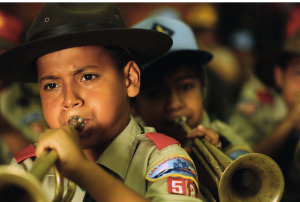NEW YORK- Tiny fingers full of paint and faces smeared in glitter fill the noisy cafeteria of St. Joseph School. “Look at my sky mommy! It has stars,” says an active 6 year old. This isn’t an art class, but Cub Scouts Pack 65.
“Welcome to the today’s Cub Scouts, where finger painting has officially replaced camping,” comments a parent.
As Cub Scouts Pack 65 faces economic and diversity concerns, competition from other activities, and a backlash for teaching non-traditional activities like art, membership continues to dwindle.
Pack 65 was established in 1995. There are currently 8 Cub Scouts on the roster. Over the past 10 years 15 boys dropped out. Conflict from parents over diversity and art helped spur the decline.
In 1997 there were 4,573,621 Cub Scouts (ages 7-10) in the nation, according to the BSA Annual Report. As of 2011, the number dropped to 1,665, 635.
The country’s economic woes are also affecting Boy Scouts of America. According to the 2009 Treasurers Report the program’s revenue fees decreased by $3,004,000 or 3.8 percent from 2008.
The decrease in funding forced Pack 65 to meet in St. Joseph School’s cafeteria, which is provided free of charge.
“Parents think because we meet in a Catholic church, we’ll preach about God, but that’s not the case,” said Jennifer Rinello, 37, pack leader. Although the neighboring public school charges for its venue, she believes meeting there instead will welcome more members and diversity.
“I haven’t broadcasted or opened up about registration to outside schools the past two years and that’s why there’s a lot less kids this year,” she explained as she fidgeted.
East Elmhurst has a high demographic of Latino-American residents. Yet, the Latino-American Scouts are the minority of Pack 65. Like other troops across the country, Pack 65 is plagued with a lack of diversity.
The absence of generational diversity also discourages new members to sign up.
“Many of our Scouts are here not because they want to be, but because their parents were former Scouts and think their children have to be too,” said Stephen Velky, 45, Scout Master.
Cub Scout values like friendliness and courteousness are typically taught through camping and hiking trips. But the pack doesn’t have sufficient funding for multiple trips. The leaders hoped via the new alternative-art-the values would still carry through.
“I think it’s great that they get to self-express themselves. I’m running an art class I guess,” said Christina Velky, 21, Cub Scout leader and prospective teacher. “But that’s not all we do. Last week I taught the Scouts how to call 911 and check the smoke detectors,” she added as she painted a flower pot with her brother.
Christina believes it’s less time consuming and cheaper to teach art.
In addition, Cub Scouts is taking the backseat to other activities. Parents no longer think it’s a good resume enhancer, especially when the focus is art.
“This whole ‘parents think BSA stands for Baby Sitters of America’ thing is not funny,” said Grant Chappell, 51, a father to a 6 year old Scout, in an annoyed voice . “My son plays baseball and is learning the guitar. I can easily pull him out; there are other activities that will get him into a good college.”
Friendliness isn’t necessarily resonating in the pack, as it should’ve through art. There was a case of bullying among the Scouts this year.
“My son comes home crying. They make fun of him at school for being a Boy Scout because the other boys think he is a baby. And then his own Scout friends say mean things to him because he always wears his uniform and knows the rules,” said Bruna Almeda, 35, while tearing.
Her son might not return to Scouts next year. He wants “to be on the basketball team like everyone else.”
The membership decrease is also a growing trend in neighboring troops.
“If anyone thinks parents have the time or the money to spend on Scouts is fooling himself,” said an Eagle Scout from a troop in Bayside, Queens. “When I was little there were almost sixty Scouts in the troop, now there are ten with two volunteers. It’s a joke.”
A recommendation to keep membership steady, is to maintain traditional programs. Traditional programs have few members.
“Traditional scouting has roughly maintained the same level of membership over the past 5 to 10 years in New York City,” said Joe Schiltz, Queens Field Director of BSA, in a reassuring tone. Joe believes Pack 65 is succeeding with its small size, in spite of losing members.
Even though Stephen and his family of 4 Scouts are moving away next year, he is trying to take the Cub Scouts outside of the dimly lit and humid cafeteria, for more “nature-based” activities. He anticipates “working together as a family in the great outdoors” will also fight the bullying.
“I don’t think I would pay for my son to do art in Boy Scouts. I’ve heard it’s a great troop, but I already enrolled him in soccer,” said Fay Pandis, 43, a mother to a 6 year old in the neighborhood. “Although I think we might be missing a big idea here. We shouldn’t care if they paint or tie knots; they’re staying out of trouble and either way they’re learning something outside of school.”
This story was originally written for NYU Journalistic Inquiry
